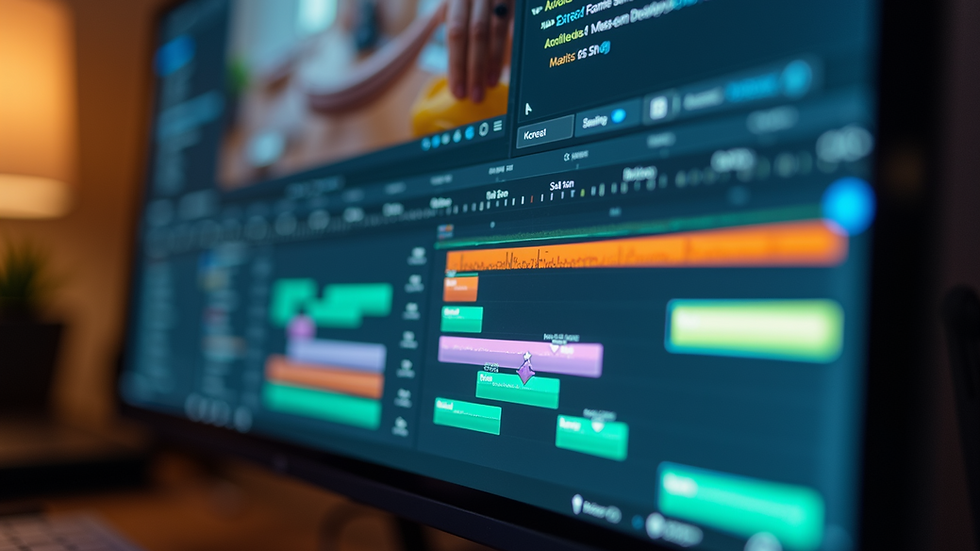Why Multimedia Storytelling Platforms Are Game-Changing
- Primarald Limited
- Aug 13
- 3 min read
In today's fast-paced digital world, capturing and holding an audience's attention is more challenging than ever. Traditional storytelling methods, while still valuable, often fall short in engaging modern viewers who crave immersive and interactive experiences. This is where digital storytelling platforms come into play, revolutionising how stories are told and consumed. These platforms combine various media forms such as text, images, audio, and video to create rich, compelling narratives that resonate deeply with audiences.
The rise of digital storytelling platforms has transformed industries ranging from journalism and marketing to education and entertainment. By leveraging technology, creators can craft stories that are not only informative but also emotionally engaging and visually stunning. This blog post explores why multimedia storytelling platforms are game-changing, how they work, and practical ways to harness their power effectively.
The Rise of Digital Storytelling Platforms
Digital storytelling platforms have emerged as essential tools for content creators aiming to connect with audiences on a deeper level. Unlike traditional media, these platforms allow for the integration of multiple content types, making stories more dynamic and engaging.
Key Benefits of Digital Storytelling Platforms
Enhanced Engagement: Combining visuals, sound, and text keeps audiences interested longer.
Broader Reach: Stories can be shared easily across social media and other digital channels.
Improved Retention: Multimedia elements help reinforce key messages, making them more memorable.
Interactive Experiences: Some platforms enable user interaction, increasing involvement and personal connection.
For example, a news outlet using a digital storytelling platform can present a breaking story with embedded videos, interactive maps, and audio interviews, providing a comprehensive understanding that text alone cannot achieve.

What is Multi-Media Storytelling?
Multi-media storytelling is the art of combining different types of media to tell a story in a cohesive and engaging way. This approach goes beyond simple text or images by integrating video, audio, animations, and interactive elements to create a richer narrative experience.
Components of Multi-Media Storytelling
Text: The backbone of the story, providing context and details.
Images: Photographs, illustrations, or graphics that visually support the narrative.
Video: Moving images that add emotion and realism.
Audio: Music, sound effects, or voiceovers that enhance mood and tone.
Interactive Elements: Quizzes, clickable maps, or timelines that invite audience participation.
By blending these components, storytellers can appeal to different learning styles and preferences, making their content accessible and engaging for a wider audience.

How Multimedia Storytelling Platforms Transform Content Creation
Multimedia storytelling platforms provide creators with the tools and flexibility to produce complex narratives without needing advanced technical skills. These platforms often feature drag-and-drop interfaces, templates, and integration with various media sources, simplifying the production process.
Practical Advantages for Creators
Time Efficiency: Streamlined workflows reduce the time needed to produce high-quality content.
Collaboration: Teams can work together in real-time, sharing assets and feedback seamlessly.
Customisation: Creators can tailor stories to specific audiences or platforms.
Analytics: Many platforms offer insights into audience behaviour, helping refine future content.
For instance, educators can use these platforms to create interactive lessons that combine video lectures, quizzes, and reading materials, making learning more engaging and effective.

Practical Tips for Using Multimedia Storytelling Platforms Effectively
To maximise the impact of your stories, consider the following actionable recommendations:
Plan Your Story Structure: Outline your narrative before adding media to ensure a clear and logical flow.
Use High-Quality Media: Crisp images and clear audio enhance professionalism and viewer experience.
Keep It Concise: Avoid overwhelming your audience with too much information or too many media elements.
Engage Your Audience: Incorporate interactive features like polls or clickable elements to encourage participation.
Optimise for Mobile: Ensure your stories look great and function well on smartphones and tablets.
Test and Iterate: Use platform analytics to understand what works and refine your approach accordingly.
By following these tips, you can create compelling stories that captivate and inspire your audience.
The Future of Storytelling with Multimedia Platforms
The evolution of digital storytelling platforms signals a shift towards more immersive and personalised content experiences. Emerging technologies such as virtual reality (VR), augmented reality (AR), and artificial intelligence (AI) are beginning to integrate with these platforms, offering even more innovative ways to tell stories.
As these technologies become more accessible, expect multimedia storytelling to become an even more powerful tool for communication across industries. Whether for marketing campaigns, educational content, or entertainment, the ability to craft engaging, multi-sensory narratives will be a key differentiator.
For those looking to explore this exciting frontier, starting with a reliable multimedia storytelling platform can provide the foundation needed to create impactful digital stories that stand out.
Embracing multimedia storytelling platforms is no longer optional but essential for anyone serious about connecting with audiences in the digital age. By combining creativity with technology, these platforms unlock new possibilities for storytelling that are both memorable and meaningful.










HOW'S IT GOING WITH GUY'S----OVER THERE TODAY.
I'm MUHAMMAD KAMAAR A Wix Partner. During a recent review, Wix’s technical team highlighted your website and recommended it to my team for support pointing out areas to improve performance, visibility on Google, and overall accessibility for users.
After conducting a detailed review, I noticed a few technical search rank hurdles, crawl errors, slow indexation, missing structured data, and accessibility gaps like unlabeled images and keyboard-navigation issues. Left unaddressed, these can limit visibility, delay Google indexing, and affect user experience.
By optimizing your site with the right search rank strategies and webpage design (including any potential redesign where needed), we can boost traffic and increase actions from visitors.
If you’re interested, I can…